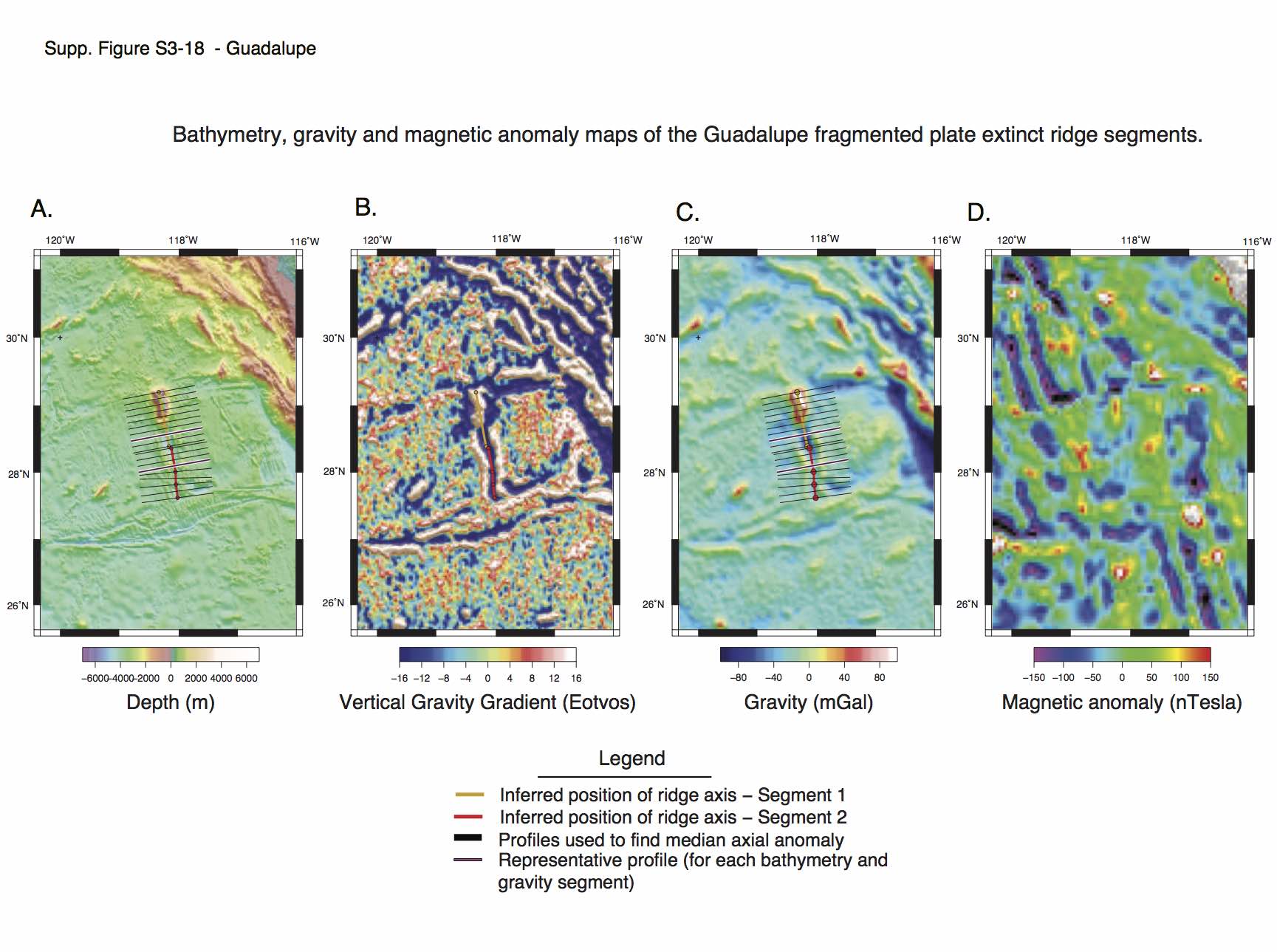| Ocean: | Pacific |
| Spreading center type: | Fragmented plate spreading ridge |
| Time of cessation: | Ca. 11 Ma, chron C5AB (Michaud et al., 2006) |
| Subsequent active spreading centre: | None in immediate region |
| Later deformation or volcanism: | The Guadalupe Island volcanoes post-date the spreading centre (Batiza, 1977). |
The tectonic fabric offshore the Baja California peninsula is complicated by several oblique ridges and deep troughs that are characterized by negative free-air gravity anomalies. The most northerly of these features, situated between 27° N and 29° N is referred to as the Guadalupe extinct spreading ridge (Lonsdale, 1991; Michaud et al., 2006). It is thought that this spreading ridge developed during fragmentation of the Farallon plate as it entered the subduction zone at the Western margin of North America, causing formation of the short-lived Guadalupe plate (Lonsdale, 2005; Michaud et al., 2006). Plate fragmentation is proposed to have occurred at numerous locations along this lengthy margin and resulted in many relict plate fragments, that have had spreading regimes that are compatible with independent poles of rotation, rather than with those of the Pacific or Farallon plates.
Batiza (1977) reported that Menard in an unpublished manuscript established that symmetric magnetic anomalies (C5B) could be located either side of Guadalupe Island. One segment of the Guadalupe extinct ridge is overprinted by a large volcano, known as Guadalupe Island. Batiza (1977) proposed that the island was formed by eruptions from two distinct volcanoes, that erupted alkali-basalt series lavas derived from a fertile mantle parent-rock. However, there are limited age constraints on the volcanism that must have occurred in the final stages of the ridges activity or after cessation. Batiza (1977) cites one published study of an alkali basalt from what is suspected to be the younger of two shield volcanoes at 7 +/- 2 Myrs (Batiza, 1977), which is a minimum of 6 Myrs later than the spreading centre ceased spreading. Batiza (1977) argues that there must have been a transition from a depleted melt source (normal MORB) for oceanic spreading to a fertile (undepleted) melt source between the time of cessation and the eruptions that formed Guadalupe Island (1977). Batiza (1977) thought it unlikely that a deep-plume was responsible for the magmatism but rather suggested that it may have been the result of a small-scale convection processes.
Lonsdale (1991) proposes that there may may be another fragmented plate spreading ridge to the north of the Guadalupe extinct ridge, termed the “Soledad” segment, that is proposed to have ceased simultaneously with the Guadalupe axial segment. Lonsdale (1991) suggested that the Soledad segment was a failed northward propagating spreading segment.
Michaud et al. (2006) propose that the cessation of spreading at this fragment of the Farallon plate was a result of reduced slab pull, as they argue that at around 14-15 Ma a large proportion of the Farallon plate had broke off. We observe that the life-span of spreading centres created by plate fragmentation appears to be limited to between 3 and 10 Myrs, which suggests a short-lived process by which magmas are generated either by the fracturing process that may lead to localized decompression melting or hydrated mantle through ingress of fluids.
The Guadalupe extinct spreading ridge is considered a well-defined extinct fragmented microplate centre and is the only type-example that has an uncontested axial location.
Batiza, R., 1977, Petrology and chemistry of Guadalupe Island: An alkalic seamount on a fossil ridge crest. Geology, v. 5, pp.760–764.
Lonsdale, P., 1991, Structural patterns of the Pacific floor offshore of peninsular California, In, Dauphin, J.P. and Simoneit, B.R.T., eds., The Gulf and Peninsular Province of the Californias, The Gulf and Peninsular Province of the 1009 Californias: Tulsa, American Association of Petroleum Geologists Bulletin, v. 47, p. 87–125.
Michaud, F., Royer, J.Y., Bourgois, J., Dyment, J., Calmus, T., Bandy, W., Sosson, M., Mortera-Gutierrez, C., Sichler, B., Rebolledo-Viera, M., and Pontoise, B., 2006, Oceanic-ridge subduction vs. slab break off: Plate tectonic evolution along the Baja California Sur continental margin since 15 Ma, Geology, v. 34, no. 1, p. 13–16.


